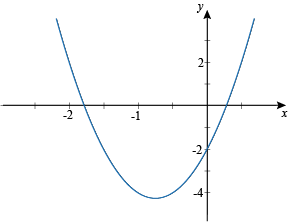The vertex form for parabolas is convenient for graphing, but oftentimes you'll be given the equation in the usual quadratic form instead.
f(x) = ax2 + bx + c
Can we deduce a way to find the vertex of a parabola from its quadratic form equation? Would we even ask the question if the answer was "No?"
Let's start with the vertex form function, and expand it to its quadratic form.
f(x) = a(x – h)2 + k
f(x) = ax2 + (-2ah)x + (ah2 + k)
Remember? We did this in the last section. It wasn't that long ago. Anyway, if you compare the second function above to the standard quadratic function, you'll notice that -2ah = b. And hey—if we're given a quadratic function, we know what a and b are just from lookin' at the equation. That means we can solve for h without batting an eyelash.
-2ah = b

While we could go ahead and solve c = ah2 + k for k, there's a much, much better way. Since h is a value of x just like any other, we can just plug h into the function and solve. That means that the vertex equals (h, f(h)), or  . Yep, that's way easier. Smarter, not harder, remember?
. Yep, that's way easier. Smarter, not harder, remember?
Sample Problem
Graph the function f(x) = 4x2 + 6x – 2.
Let's start off by looking for the vertex. Using our handy-dandy new formula, we find:


Next we plug h in for x to find y. Golly, that's a lot of variables.

So the vertex is  . By the way, the rule about the a-value telling us which direction our parabola opens? Yeah, that still applies. Since a is positive 4 in this case, our parabola opens upward.
. By the way, the rule about the a-value telling us which direction our parabola opens? Yeah, that still applies. Since a is positive 4 in this case, our parabola opens upward.
The y-intercept is easy to find; just track down f(0):
f(0) =4(0)2 + 6(0) – 2 = -2
That puts our y-intercept at (0, -2).
Next we'll check to see if any x-intercepts exist. The discriminant is b2 – 4ac = 62 – 4(4)(-2) = 36 + 32 = 68. That's positive, so we have two real number roots, a.k.a. two x-intercepts. Quadratically formulating a solution, we get:

Notice that we already know what goes under the square root, because we calculated the discriminant.


Bam:  and
and  are our x-intercepts, which are equal to about (0.281, 0) and (-1.781, 0).
are our x-intercepts, which are equal to about (0.281, 0) and (-1.781, 0).
These are enough points for us to graph the function, so let's do that.

When our function is in quadratic form, we pretty much follow the same steps we did in vertex form: find the vertex, find the intercepts, and hunt down any extra points we need to round things out.